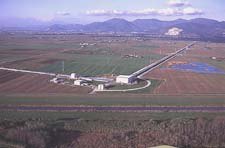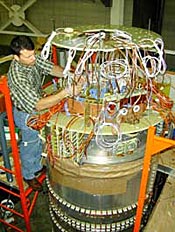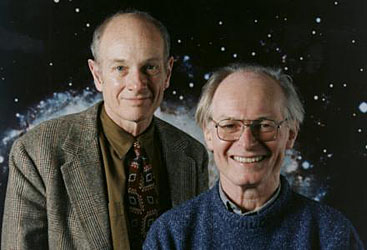
Overview
This document, International Dimensions of NSF Research and Education, provides a broad-brush picture of the major international activities of the National Science Foundation (NSF). It is comprehensive but not exhaustive. Its intent is to illustrate the many ways in which the Foundation interacts with the rest of the world to advance science and engineering research and education.
NSF Strategic Goals in a Global Context
International activities are an integral part of the National Science Foundation’s mission. They are guided by NSF's strategic goals and key strategies.
NSF's international role in science and engineering is guided by its key strategic goals of People, Ideas, and Tools -- that is, investing in a diverse, internationally competitive and globally engaged workforce of scientists, engineers and well-prepared citizens; investments in discovery across the frontier of science and engineering, connected to learning, innovation, and service to society; and broadly accessible, state-of-the-art and shared research and education tools.
In today’s world, NSF cannot achieve its goals in isolation. Increasingly in the future, US scientists and engineers must be able to operate in teams composed not only of people from many disciplines, but also from different nations and cultural backgrounds. New ideas emerge from the intellectual interactions of people from diverse backgrounds everywhere and in every country. Many scientific tools, both large facilities and large distributed and networked databases, will necessarily involve international partners. Therefore, NSF undertakes or participates in international activities whenever it contributes to accomplishing NSF’s overall goals more effectively.
The National Science Board's report, Toward A More Effective NSF Role in International Science And Engineering (NSB-00-217), recently underscored the need for NSF's investments in international science and engineering to be strategic. International science and engineering should be “a high priority for NSF, with a much stronger focus and a much higher level of visibility” in the future. NSF should emphasize international considerations "more explicitly in its research and education programs, both in core disciplines and in NSF wide initiatives." NSF's Office of International Science and Engineering (INT) is spearheading the response to the Board's recommendations.
The NSF International Portfolio
NSF's international portfolio has a long history that goes back at least to the International Geophysical Year (IGY 1958-59), an unprecedented global research effort in sixty-seven nations to make synoptic observations of the planet during a period of maximal solar activity and the subsequent establishment of multinational scientific programs in Antarctica.
Over the years, NSF has conducted numerous multilateral projects from the International Biological Program (IBP) and TOGA (tropical oceans, global atmosphere) to the more recent ones described in this report. It has also fostered bilateral partnerships in all parts of the world -- many of these in tandem with major diplomatic initiatives such as initiating cooperation with the USSR in the 1970s and China in the early 1980s.
Today, NSF’s international activities are extensive and encompass both the financial resources provided to the science and engineering community and the efforts of NSF management and staff who exercise leadership in international settings, fostering institutional frameworks that facilitate international cooperation in research and education. They support research programs distributed across the Foundation's directorates, the training of graduate students and postdoctoral fellows and, to a lesser extent, undergraduate and pre-college education programs.
These activities are widely distributed across the continents and oceans of the world and range from work in the world’s most advanced science and engineering laboratories to observation of physical, biological, and human phenomena around the globe, including its polar regions.
NSF estimates that between 5 and 10 percent of its budget is expended on some aspect of international activity and each year its support enables an estimated 10,000 or more US scientists and engineers to engage in international projects.
The senior management of the Foundation plays a major role in international statesmanship. Besides interacting with the scientific leadership of other countries, senior NSF staff participates in such international bodies as the Global Science Forum (GSF) of the Organisation for Economic Cooperation and Development (OECD), the Board of Trustees (BOT) of the Human Frontier Science Program (HFSP), the International Group of Funding Agencies for Global Change Research (IGFA), the activities of the Arctic Council, the consultative meetings of the Antarctic Treaty, and the scientific activities of such UN specialized agencies as the World Meteorological Organization (WMO).
This document is organized in five sections:
-
US participation in global-scale projects and research networks This section covers more than two dozen international-scale projects in which NSF plays a lead role as well as many others in which NSF participates.
-
Support for international facilities This section covers both Foundation-supported facilities overseas, such as the Gemini-South facility in Chile, and those on US soil that represent international partnerships, such as Gemini-North in Hawaii.
-
Linkages to Research Programs of Other Countries The section covers intergovernmental agreements of S&T cooperation in which NSF is involved. It also covers joint programs designed to facilitate the involvement of NSF-supported US scientists and engineers in international collaboration.
-
New Scientists and Engineers The section provides an overview of Foundation approaches that provide US scientists and engineers with opportunities to gain international professional experience.
-
International Science and Engineering Information This section outlines some of the approaches currently used by the Foundation to tracking developments in research and education in other countries.
![]()
Global-Scale Projects and Research NetworksThe National Science Foundation plays a lead role in more than two dozen international-scale projects and is a major participant in many others. The Foundation provides substantial financial support for these projects and the Foundation's senior management and staff play major roles in shaping, managing, and coordinating the programs in both national and international contexts. The following gives an overview of the major international initiatives undertaken or supported by the NSF. One of the largest and most extensive internationally coordinated research programs ever undertaken,the US Global Change Research Program (USGCRP), involves major resource commitments from ten US government agencies, about 1.7 billion. Created as a Presidential Initiative in 1989 and formalized in 1990 by the Global Change Research Act of 1990, since that time global change research has remained a key science initiative. Continuing to improve scientific understanding of the Earth system is a priority of the National Science and Technology Council's Committee on Environment and Natural Resources. USGCRP scientists coordinate many of their programs with those of their counterparts in other countries to aggregate the scientific and financial resources needed for the study of global processes on a cohesive and comprehensive basis. This coordination is achieved through a series of global and regional programs. Some of the most important of these international connections are identified in Our Changing Planet (FY2002), the latest in a series of yearly reports on the USGCRP that accompany the President's Annual Budget. Also, the US Global Change Research Information Office (GCRIO) provides access to data and information on global environmental change research and global change related educational resources on behalf of the USGCRP The Foundation's Global Change Research Program supports research to advance fundamental understanding of dynamic physical, biological, and socioeconomic systems and the interactions among them. The programs encourage interdisciplinary activities with particular focus on Earth system processes and the consequences of change. NSF's Office of Polar Programs (OPP) supports the the Polar UV Radiation Monitoring Network, a high-latitude network of scanning spectroradiometers operated since 1988 at three sites in Antarctica (McMurdo Station, Palmer Station, and South Pole Station), two sites in the US ( Barrow, Alaska and San Diego, California),and one site in Ushuaia, Argentina. Data from these sites has proved invaluable in research on the effects of increased UV radiation due to ozone depletion. |
|
LEFT: The Ushusia instrument is installed in the roof of the main CADIC building and is surrounded by mountains ranging in elevation from 2.5° (at bearings of 120° - 206°) to 17° (at bearings of 298° - 302°). Progress on global change research topics would be impossible without advanced instrumentation. For example, the NSF Polar UV Monitoring Network is made up of six SUV-100 scanning spectroradiometers. The Ushuaia, Argentina installation, the fourth system added to the network, is located near the southern port city of Ushuaia, Argentina, at the Centro Austral de Investigaciones Cientificas (CADIC) facility. CADIC is a regional research center of the National Research Council of Argentina (CONICET). The installation is located in the foothills of the Andes, an area subject to frequent clouds. |
||
|
In order to achieve understanding of world wide sea level changes, the NSF's global geodetic program is supported through the University NAVSTAR Consortium (UNAVCO), which has an international membership; a substantial fraction of the currently-supported projects are outside the U.S., and involve cooperation with the national geodetic agencies of other countries.
The RIDGE Program was phased out recently and a new RIDGE 2000 Program took its place. RIDGE 2000 is a community-based science initiative focused on integrated geological and biological studies of the Earth-encircling mid-ocean ridge system. Central to the RIDGE 2000 Science Plan is the recognition that the origin and evolution of life in deep-sea ecosystems are inextricable linked to, and perhaps an inevitable consequence of, the flow of energy and material from Earth's deep mantle, through the volcanic and hydrothermal systems of the oceanic crust, to the deep ocean. The program recognizes that the complex linkages between life and
planetary processes at mid-ocean ridges can only be understood through
tightly integrated studies that span a broad range of disciplines
and three sites have been chosen as the initial RIDGE 2000 Integrated
Study sites The four major international elements of the international global change research effort are the World Climate Research Program (WCRP), the International Geosphere-Biosphere Program (IGBP), the International Human Dimensions Program (IHDP) and Diversitas. How humans interact with the environment, how individuals and societies can mitigate or adapt to environmental change, and how policy responses to such changes influence economic and social conditions are at the center of research on the human dimensions of global environmental change within the IHDP. Key IHDP programs underway address Land Use and Land Cover Change and the Institutional Dimensions of Global Environmental Change. |
||
NSF also plays a key role in hemispheric or regional global change research efforts, One of the three regional institutes for global change research – Inter-American Institute for Global Change Research (IAI) is an intergovernmental organization with U.S. participation dedicated to global change research, to augmenting the scientific capacity of the Americas, and to providing information in a useful and timely manner to policymakers. The primary objectives of the support that the NSF provides to the IAI on behalf of the United States are to encourage comparative research and focused global change research important to the region as a whole and beyond the scope of individual national programs. The other two regional networks, the European Network for Research in Global Change (ENRICH) and the Asia-Pacific Network for Global Change Research (APN), were also created to facilitate the integration of global change research programs on a regional basis. The Global Change System for Analysis, Research, and Training (START) program involves developing countries more fully in global change research. See also GEO International Activities. |
||
|
GCRP major international studies and experiments involving NSF support currently include:
See also:
US GLOBEC |

In one ARCSS project, the Greenland Ice Sheet Project II (GISP2), an ice core was recovered from the Summit of the Greenland Ice Sheet where ice thickness is greater than 3000m. |
|
In addition to the research focused on global change, NSF continues to conduct research on topics closely related to global change. In addition, many NSF-sponsored research projects consider interactions linking ecosystems and human activities with other factors including climate variability and change. Examples include the Long-term Ecological Research sites, which provide perspectives on ecological responses to climate change and other stresses: Antarctic Ecosystems; and Coastal Long-Term Ecological Research NSF's Geosciences Directorate (GEO) also supports the interagency National Space Weather Program (NSWP), upper atmosphere research to provide timely, accurate and reliable space environment observations and forecasts. These are enriched by data from state-of-the-art facilities from Sondestrom, Greenland to Jicamarca, Peru, which provide arrays of optical and radio wave remote sensing instruments for observing and measuring changes in Earth's upper atmosphere and near-space environment. In the lower atmosphere/ocean interface, NSF's Geosciences Directorate (GEO) supports the Global Tropospheric Chemistry Program(GTCP), a major contributor to a number of IGBP and WCRP programs, and the WCRP's Climate Variability and Predictability Program (CLIVAR). See also US CLIVAR site and International CLIVAR sites. |
|
|
||
Facilities and infrastructure for the above programs is provided through the interagency funded U.S. academic research fleet of more than two dozen vessels; a number of research aircraft; sample storage facilities for the ODP;the upper atmosphere observatories in Greenland (Kangerlussuaq (Sondre Stomfjord)) and in Peru (Jicamarca Radio Observatory). (See photo: Optical backscattering from arctic noctilucent clouds at 85 km altitude measured with the Rayleigh lidar at Kangerlussuaq (Sondre Stomfjord), Greenland.) Facilities supported under NSF CEDAR(Coupling Energetic and Dynamics of Atmospheric Regions) include the Bear Lake Observatory in Utah, the Longyearbyen Optical Station in Norway, and the Early Polar Cap Observatory in Resolute Bay, Canada. With international collaborations from the Far East to Europe, the Center for Clouds, Chemistry, and Climatefacilities are supported as an NSF Science and Technology Center. NSF/GEO and the National Oceanographic and Atmospheric Administration (NOAA) support the large deployment of facilities for the field experiment of the Fronts and Atlantic Storm-Track EXperiment (FASTEX). The NSF/GEO Global Seismic Network (GSN) is the U.S. component of an international set of globally deployed seismographs. The United States participates with France, Japan, the United Kingdom, Mexico, Canada, and Italy in a federation of networks that provides shared access to seismic data. GSN is managed by the Incorporated Research Institutions for Seismology (IRIS). GEO is also involved in the international system for the exchange of scientific data and information, through geographic information systems (GIS), and related activities. NSF/OPP is charged with managing all U.S. activities in the Antarctic as a single, integrated program. NSF/OPP participates on the delegations of two Antarctic treaties: the Antarctic Treaty, which sets aside Antarctica for peaceful purposes and encourages international scientific collaborations and the Convention for the Conservation of Antarctic Marine Living Resources, which regulates commercial fishing and directs scientific research to preserve the marine ecosystem. The US Antarctic Program (USAP) maintains Antarctica as an area of international cooperation reserved for peaceful purposes, to pursue unique opportunities for scientific research to understand Antarctica and its role in global environmental systems, to protect the relatively pristine environment and its associated ecosystems, and to assure the conservation and sustainable management of the living resources in the surrounding oceans.
OPP international work includes International Trans-Antarctic Scientific Expedition (ITASE), an international effort to collect and interpret a continental wide array of environmental parameters including transfer functions between the atmosphere and snow/ice interface. Scientists from 15 countries are traversing Antarctica, collecting ice cores and gathering data that will describe climate and environmental change over the past 200 years. US ITASE is, collecting surface and near surface snow and ice samples and conducting radar studies to determine the internal stratigraphy and bedrock topography of the terrain along a traverse in West Antarctica. (See Map: West Antarctica Showing US ITASE traverse corridors.) One major large-scale multinational project is Man and the Biosphere Program (MAB) coordinated under the auspices of the United Nations Educational, Scientific, and Cultural Organization (UNESCO). NSF supports U.S. participation in such projects as the Biological Research Inventorying and Monitoring (BRIM) program and the Northern Sciences Network. The Arabidopsis Genome Initiative (AGI)is a major international plant biology effort that involves more than 2,500 laboratories and 8,000 scientists worldwide using a new generation of tools to probe this plant's genome. The AGI began in 1996, unifying the efforts of international teams who had been decoding this important genome sequence since the early 1990s. Representatives from each of the major Arabidopsis sequencing centers met at the NSF to agree on a collaborative approach. In the US, an interagency program began in 1996 with funds from NSF, the Department of Energy and the Department of Agriculture . The European Union, the Government of France, and the Chiba Prefectural Government in Japan similarly support AGI research. |
This achievement, by the AGI international consortium of scientists became public in the journal Nature's December 14 issue, describing how researchers sequenced the entire genome of this weed in the mustard family. For a list of the individuals worldwide who contributed to the Nature issue, see Arabidopsis Genome Initiative Contributors. Also, the Arabidopsis Information Resource (TAIR) provides a comprehensive resource for scientific communities working withArabidopsis thaliana. |
|
|
Also, in the biological sciences, the Human Frontier Science Program (HFSP) is a multinational effort to enhance international collaboration in basic research focused on complex mechanisms of living organisms; fields supported range from brain functions to biological functions at the molecular level.
The Foundation and other three federal agencies contribute to the program which involves involve extensive collaboration among teams of scientists working in different countries, fellowships available to scientists who wish to work in a laboratory in another country, with emphasis on individuals early in their careers, and workshops. In 1999, to mark the tenth anniversary of the Human Frontier Science Program, ceremonies were organized on three continents: one in Tokyo , one in Strasbourg, and a third in Washington in December 1999. The 10th Anniversary brochure captures outstanding achievements of the program over the decade, including the awarding of five Nobel Prizes to researchers from four countries (Germany, Switzerland, UK, and US) after being involved in a Human Frontier Science Program project. An essential component of the Human Frontier Science is " Intercontinentality" Between 1990 and 1998, 372 research grants were awarded. In most cases, cooperation extended to three, four or five laboratories, situated in as many countries, linking up as many as four continents in a common research effort. Four-fifths of the projects involved two or more continents—and a third at least three continents. The NSF/BIO supports the Protein Data Bank (PDB), the single worldwide repository for the processing and distribution of 3-D biological macromolecular structure data. The NIH, DOE and the NSF fund the PDB, managed by the Research Collaboratory for Structural Bioinformatics (RCSB), a consortium comprised of: Rutgers, the State University of New Jersey, the National Institute of Standards and Technology (NIST), and the San Diego Supercomputer Center (SDSC) The PDB allows for complex queries and facilitates access to other databases through linkage and integration. In addition to PDB partner sites in the US, PDB supports sites in the UK, Singapore, Japan, and Brazil, and updates for sites in Argentina,Australia, China France, India, Israel, Poland, and Taiwan. NSF/BIO also supports expanding an international group of Long-term Ecological Research (LTER) Network sites. Global scientific interest in developing long-term ecological research (LTER) programs is expanding very rapidly, reflecting the increased appreciation of their importance in assessing and resolving complex environmental issues. As of May 2000, twenty-one countries had established formal national LTER programs and joined the ILTER network. Ten more were actively pursuing the establishment of national networks and many others had expressed interest in the model. Most member networks contributed to a 1998 book on the ILTER network. Country chapters may be consulted on line. There is also a table summarizing characteristics of the networks. This group meets annually in one of the member countries. Reports of past meetings are available. The 1999 Annual International LTER Meeting was held in Kruger National Park, South Africa, August 16, 1999 There was extensive discussion of opportunities for network-wide research collaboration, including several activities coordinated by international environmental networks associated with ILTER the Global Terrestrial Observing System (GTOS)and GTNET. (See photos from the Kruger National Park field trip.) |
 |
Members of the ILTER Network:
|
|
Other NSF/BIO large-scale projects include the interagency NeuroLab (NASA/NSF/NIH/NIMH/ONR and international partners). Neurolab is a collaborative effort of many nations of the world, responsive to the congressionally declared Decade of the Brain. A NASA Neurolab Mission in April 1998 was dedicated to neuroscience-related experiments on animals and humans.Data from the flight has not yet been analyzed. NSF/BIO expects such work will advance research on how microgravity and other features found only in space flight affect nervous systems, add to public education about neuroscience and space technology, and provide potential benefits to applied aspects of neuroscience. Another large-scale NSF/BIO project is FLYBRAIN, an online atlas and database of the Drosophila nervous system involving Germany and Japan. Facility support and research grants to the Organization for Tropical Studies (OTS) a nonprofit consortium of 64 universities and research institutions in the US, Costa Rica, Perú, Canada, South Africa, México and Australia are also funded by NSF/BIO, including the Arthropods of La Selva Project (ALAS), a large-scale inventory of arthropod diversity in a lowland tropical rainforest, The project represents a collaboration not only between disciplines, but also between OTS and Costa Rica's National Biodiversity Institute (INBio). |
|
|
Copiphora cf. cultricornis - one of the new species of katydids discovered by ALAS investigators |
|
|
Partially supported by the NSF Office of International Science and Engineering(INT), students in OTS Duke University courses visit a series of OTS biological field stations, including the Palo Verde Research Station, in northwest Costa Rica, and the LaSelva Biological Station, one of the world's leading centers for research on tropical rainforest ecology. With advice and assistance from faculty, students design and carry out their own short research projects. NSF/BIO funds International Cooperative Biodiversity Groups(ICBG), an interagency (NSF/NIH/USDA) activity to support "bioprospecting" for potential therapeutic agents in the context of biodiversity conservation and sustainable economic development in developing countries. A second cohort of 5-year awards was announced in FY 2000 (NIH Press Release ). Six groups of diverse private and public institutions, including universities, pharmaceutical companies and environmental organizations, will collaborate on projects in ten countries. Support for this program will total approximately $3.5 million per year over the next five years, shared among the NIH, NSF, and USDA. As one example, the Bioactive Agents from Dryland Biodiversity of Latin America project is an extension of ICBG research begun in 1993. The project involves discovery and development of pharmaceuticals and crop-protection agents from plants and microbes of arid and semi-arid ecosystems in Chile, Argentina and Mexico. Results show promise for developing prescription medicines that may aid in treatment of infectious diseases, cardiovascular, central nervous system and gastrointestinal disorders. Extension of the grant allows expanding into new ecosystems such as islands off the coast of Chile, parts of southern Mexico, and the Chaco area of northern Argentina The project involves participants in the US, Chile, Argentina and Mexico. Biocomplexity in the Environment(BE)is a multi-year NSF competition designed to promote new approaches to investigating the interactivty of biota and the environment -- the interrelationships that arise when living things at all levels- from molecular structures to genes to ecosystems--interact with their environment. Researchers work in diverse fields that go beyond biology to physics, systems engineering, economics, geochemistry and others, on studies from the submolecular to mass changes in climate with potential for worldwide impact. The FY2000 Competition supported research to advance understanding of interacting biological, physical and social systems, so that our ability to predict system behavior is enhanced (NSF Press Release 00-73). The FY 2001 Competition promoted comprehensive, integrated investigations of environmental systems using advanced scientific and engineering methods. Investigators were encouraged to adopt a global perspective . |
| ...Investigators are encouraged to identify international research partners, as appropriate. Planning visits for groups of researchers to consider larger scale collaborative efforts may be requested, as well as support for collaboration between individuals. For some developing countries, funds for equipment as well as support for human resources development in those countries may be requested....NSF may also be interested in other means of developing support for collaborative research, education, and outreach in the topical areas of this competition....For information on international collaborative programs, see NSF 00-138. | ||||||
|
Initial awards were announced in November 2000 to fund 12 research projects under a new Ecology of Infectious Diseases initiative. The NSF/BIO and NIH initiative supports efforts to understand the underlying ecological and biological mechanisms that govern relationships between human-induced environmental changes and the emergence and transmission of infectious diseases. (NSF Press Release 00-86) Awards include:
In order to bring biodiversity information to the Internet, where it will be freely accessible to anyone, a consortium of 28 interested countries and intergovernmental organizations is coordinating plans to form the Global Biodiversity Information Facility (GBIF). NSF/BIO senior management chairs the interim steering committee for GBIF, consisting of a series of interconnected databases containing information about the worldís living organisms, from bacteria to plants to mammals. (NSF Press Release 00-67). For the NSF Computer & Information Science and Engineering Directorate (CISE), the number of large-scale multi-institutional projects with international partners continues to grow. Historically,from the early days of the NSFNET, international networking activities have helped to connect the US research and education community with academic counterparts and resources around the world. The International Connections Management (ICM) project (1991-96) assisted about 25 countries in connecting to the NSFNET. One highlight of the ICM project was a satellite teleport gateway for Latin America in Homestead, Florida. Another was a connection for Mongolia in 1996. Among ICM's "firsts" was a 45 Mbps trans-Atlantic link to London in July, 1995 (a record-breaking capacity at that time). The link continued on at 34 Mbps to Stockholm to join NSFNET with NORDUnet. This opened the door to what are now many transoceanic fiber links at 45 and 155 Mbps. More recently, international networking activity established the Science, Technology and Research Transit Access Point (STAR TAP) in Chicago as a persistent anchor for interconnecting NSF's very-high-performance Backbone Network Service (vBNS) with advanced networks that are dedicated to supporting high-performance applications and developing new networking technologies. By early 1999, about 15 country nets as well as the U.S. Next Generation Internet (NGI) networks and Abilene had been interconnected at STAR TAP. The High-Performance International Internet Services (HPIIS) project made awards for sharing some of the costs of the high-performance connections to TransPAC, a U.S.- Asia-Pacific consortium, to MirNET, a U.S.- Russia consortium, and to Euro-Link,a connection of European and Israeli National Research Networks (NRNs) to the high-performance vBNS and Abilene networks. Today,STAR TAP is the premier global exchange point for advanced international networking, in support of applications, performance measuring, and technology evaluations. STAR TAP is documenting the international collaborations it helps foster. The complete set of applications as of October 20, 2000 is available by category and event. Examples of STAR TAP iGrid 2000 applications demonstrate how the power of today's research networks enables access to remote computing resources, distribution of digital media, and collaboration with distant colleagues.
|
||||||
Funds from NSF and other sponsors are helping the African Network Operators Group (AFNOG) prepare African network engineers to manage email, mailing lists, World Wide Web, domain name servers and help desks as demand for services expands rapidly. AFNOG’s first benefits emerged due to an intensive, five-day series of courses held at the University of Cape Town, South Africa in May 2000. Organizers from Ghana, Kenya and Uganda arranged for sessions led by instructors from Ghana, Togo, Mali, South Africa, the US, the United Kingdom and the Netherlands. (NSF PR 00-50) Founded in 1999, AFNOG works with the Network Startup Resource Center (NSRC), a non-profit organization that for the past decade has helped design and deploy computer networks in Asia, Africa, Latin America, the Caribbean and the Middle East. Under an NSF/CISE award, the NSRC works in collaboration with the Advanced Network Technology Center (ANTC) at the University of Oregon to help international academic institutions and non-governmental organizations (NGOs) gain Internet access. The need for such grass-root efforts to bridge the international Digital Divide was affirmed at the July 2000 G-8 Economic Summit in Okinawa, Japan. The participating nations agreed to establish a Digital Opportunity Task Force to promote the adoption of information technologies in developing nations. |
|
DLI2 International Digital Libraries ProjectsBuilding on and extending prior Foundation efforts in digital libraries research, CISE and the Office of International Science and Engineering (INT) issued the International Digital Libraries Collaborative Research Program Solicitation NSF 99-6 intended to contribute to the fundamental knowledge required to create information systems that can operate in multiple languages, formats, media, and social and organizational contexts. Collaborative creation of new research understandings, tools and ideas exploiting the different opportunities offered by materials and technologies in use in different countries was strongly encouraged. |
|
|
Also, a series of joint NSF-European Union (EU) Working Groups on Future Directions for Digital Libraries Research were set up and reported on their efforts to jointly explore technical, social and economic issues, plan common research agendas, share research results, and explore national, technical, and social expectations about digital libraries. NSF Partnerships in digital libraries also were encouraged:
Regarding large-scale projects, the NSF Directorate for Physical and Mathematical Sciences (MPS) supports the Global Oscillation Network Group (GONG), a project to conduct a detailed study of solar internal structure and dynamics using helioseismology. (NSF Press Release 00-15)
Helioseismology utilizes waves that propagate throughout the Sun to measure, for the first time, the invisible internal structure and dynamics of a star. In order to exploit this new technique, GONG has developed a six-station network of solar velocity imagers located around the Earth to obtain continuous observations of the oscillations of the Sun. The six sites comprising the GONG Network are:
NSF/MPS, NSF/ENG, and the Office of International Science & Engineering (INT) is attempting to create an internet-based worldwide materials research network to enhance scientific and educational collaborations. With this objective, a series of international workshops have been sponsored to help stimulate enhanced collaboration among materials researchers and create networks linking the participating countries. (See also the newsletter of the International Union of Materials Research: http://iumrs.org) |
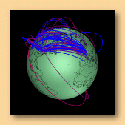 In August 2000, the U.S.-Africa Materials Workshop
was held in Pretoria, South Africa to explore opportunities for US-African
cooperation.
In August 2000, the U.S.-Africa Materials Workshop
was held in Pretoria, South Africa to explore opportunities for US-African
cooperation.Participants focused on six thematic areas: materials education and training; civil infrastructural materials; materials characterization; the materials value chain; advanced and emerging materials; and polymers and composites. The workshop attracted more than 60 participants including about 45 from African nations. |
||
|
Other regional workshops also identified possible areas for mutually beneficial collaborations.
A sixth workshop involving the Middle East countries is being explored. As a result of the NSF-EC workshop, and as part of the implementation of an Agreement for Scientific and Technological Cooperation Between the European Community and the Government of the United States of America, the NSF entered into an implementing arrangement with a European Union program that supports materials research. Since December 1999 three "Dear Colleague" letters have been issued announcing opportunities for cooperative activities in materials research between US and European researchers to be supported by NSF and the EC. One project under this competition, Current Induced Magnetic Switching in Sub-micron Sized Multilayers, is a joint undertaking between Michigan State University's Condensed Matter Physics - Experimental group and the Université de Paris Laboratoire de Physique des Solides in Orsay, France. The research concerns the current induced magnetic switching in sub-micron sized multilayers. This topic is of great importance both on account of its intrinsic interest, as well as for its technological relevance.
The Antarctic Muon and Neutrino Detector Array (AMANDA) neutrino telescope project at South Pole Station -- a US-Sweden-Germany-Belgian collaboration, jointly supported by NSF's OPP and MPS, the Department of Energy (DOE), and several European agencies -- is the world's largest detector of the neutrino--and the first that can claim to be an astronomical instrument rather than a physics experiment. AMANDA was featured in Scientific American's "Extreme Engineering" February 2000 issue, in the article " Seven Wonders of Modern Astronomy " -- The Wierdest Wonder. AMANDA trades sensitivity for the sheer size needed to catch high-energy neutrinos from distant objects, which include the swirling gas around black holes, the innards of stellar explosions, the decomposition of the unidentified matter that dominates our cosmos. So far the $7-million collaboration consists of 424 glass orbs, each the size of a basketball. Scientists watch for the glow indirectly emitted when neutrinos collide with atomic nuclei in the ice or underlying rock. The orbs point downward so that Earth will screen out extraneous particles. Ultimately, scientists want 5,000 orbs on 80 cables throughout a cubic kilometer of ice. (Images: University of Wisconsin The Amanda Collaboration)
The major participation of NSF's Education and Human Resources Directorate (EHR) in large-scale international efforts is through support of a series of multinational studies in education to help inform US education priorities. TIMSS 1999, a successor to the acclaimed 1995 Third International Mathematics and Science Study (TIMSS), focused on the mathematics and science achievement of eighth-grade students.The TIMSS- 1999 Benchmarking Report news conference on April 4, 2001 in Washington, D.C. included remarks by the NSF Director (NSF Press Release 01-24 ) The Executive Summary shows US eighth graders performed significantly above the TIMSS international average in science, but about in the middle of the achievement distribution of the 38 participating countries (above 18 countries, similar to 5, and below 14). World class performance levels were set essentially by four Asian countries and a central European one. Chinese Taipei, Singapore, Hungary, Japan, and the Republic of Korea had the highest average performance. |
|
The Foundation also supports U.S. participation in the International Council of Scientific Unions (ICSU), its constituent societies, and several of its scientific committees such as the Committee on Data for Science and Technology (CODATA), the Scientific Committee on Antarctic Research (SCAR), the Special Committee on Oceanic Research (SCOR), the
Scientific Committee on Problems of the Environment (SCOPE). Support for these components totals about $2 million annually. In convening a World Conference on Science for the Twenty-First Century , from 26 June to 1 July 1999 in Budapest, Hungary, ICSU and the United Nations Educational, Scientific and Cultural Organization (UNESCO), in co-operation with other partners, provided a unique forum for discussion between the scientific community and society. The World Conference on Science was conceived as a process consisting of a preparatory phase, the Conference itself and a follow-up program on science for the twenty-first century. |
|
![]()
NSF Support for International FacilitiesThe Foundation is the primary supporter of a number of facilities that are predominantly international in character. Some of these facilities are located overseas, in which cases there are explicit frameworks for multinational support, with foreign contributions often provided in-kind. In those cases where the facilities are located on U.S. soil, construction and operating costs are most often (but not always) borne by the Foundation.The Gemini North telescope dedicated on June 25, 1999, near the summit of Hawaii's Mauna Kea, is an example of international cost-sharing of a facility on US soil. (NSF Media Advisory PA/M 99-16) Overseas FacilitiesThe international facilities supported by NSF/MPS in the Astronomical Sciences include: |

|
NSF is responsible for the
design, development, and construction of facilities for ground-based
astronomy research. An early example is the Cerro
Tololo Interamerican Observatory (CTIO) constructed in Chile more
than 25 years ago. Since such facilities are increasingly complex
and costly, it is more and more common to seek partnerships, including
international ones, to enhance scientific, technical, and educational
value and increase cost effectiveness. CTIO is operated by the Association of Universities for Research in Astronomy Inc. (AURA), under a cooperative agreement with NSF/MPS as part of the National Optical Astronomy Observatory (NOAO); AURA also is the operating agency for the US portion of the Gemini Observatories.CTIO has annual operating costs of about $6.5 million. |
|
Astrophysicists announced in the May 11, 2000 issue of Nature. the first observations of cosmological shear, an effect predicted by Einstein's theory of relativity. The discovery casts light on the distribution of the dark matter that makes up much of the universe. Using CTIO and a method known as weak gravitational lensing, the scientists were the first to map the distribution of dark matter over large swaths of the sky. (NSF Press Release 00-29) NSF/MPS serves as the executive agency for the Gemini Observatory, an international project with seven partner nations (the U.S., the UK, Canada, Australia, Chile, Brazil and Argentina). The Gemini Observatory consists of two 8-meter telescopes, one located at Mauna Kea, Hawaii, (Gemini North) and Cerro Pachón in central Chile (Gemini South), and hence provides full coverage of both hemispheres of the sky. Both telescopes incorporate new technologies that allow large, relatively thin mirrors under active control to collect and focus both optical and infrared radiation from space. Gemini North began science operations in mid-2000 and Gemini South about a year later.(NSF Media Advisory PA/M 99-16) |
||
 This
image of the Circinus Galaxy was taken with
NOAO's Abu infrared camera during testing at the Gemini South
telescope. This
image of the Circinus Galaxy was taken with
NOAO's Abu infrared camera during testing at the Gemini South
telescope.Under the Gemini Fellowships program, postdoctoral scholars from the Gemini partner countries of Argentina, Brazil, and Chile are brought to US institutions on research fellowships. In FY2000 AURA initiated a program, in cooperation with Fondacion Andes, to provide opportunities for Chilean graduate students to pursue doctoral degrees in the US. |
||
|
NSF/MPS is also involved in the Atacama
Large Millimeter Array (ALMA) project, a developing international
partnership with the European community, to place a new radio facility
in northern Chile. Potential future partners are Canada and Japan.
NSF provided funds for design and development of the facility for
3 years. The project is preparing to move into the last year of
design and development before project construction. The European
partnership, should the project move forward, will provide 50% of
total project funding.
NSF/MPS, in partnership with the Department of Energy, is involved in the development of a major international high energy physics project, the Large Hadron Collider (LHC), that will be located at CERN(European Laboratory for Particle Physics) in Geneva, Switzerland. The LHC is an accelerator which brings protons and ions into head-on collisions at higher energies than ever achieved before. This will allow scientists to penetrate still further into the structure of matter and recreate the conditions prevailing in the early universe, just after the "Big Bang". |
||
| The LHC will be built astride the Franco-Swiss border west of Geneva, at the foot of the Jura mountains, in front of the Alps. Support for this project will be provided by several European countries and the US. NSF and the DOE would contribute to the construction of two detectors for this facility. | 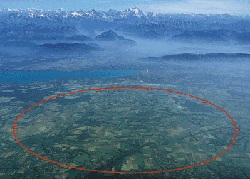 |
|
Another example of the NSF/MPS role in funding large detectors is the Pierre Auger cosmic ray detector project. This is a multinational effort in which NSF/MPS and DOE are contributing equally to the construction costs. The US costs will be $15 million, about 15% of the total. NSF and DOE share the responsibilities for oversight of the US part, with neither agency designated as lead. NSF-supported researchers are leading this project. The Center for Astrophysical Research in Antarctica (CARA) is a consortium of US universities run from the University of Chicago. CARA is an NSF Science and Technology Center (STC). The STC Program is administered through the Office of Integrative Activities (OIP) at NSF. The activities of CARA include the siting of telescopes in Antarctica. CARA is funded and managed by NSF/OPP. |
|
|
|
|
|
The Cape Roberts Project, supported by NSF/OPP, is an international ocean-floor drilling program aimed at recovering paleoenvironmental records from the time when ice sheets were just showing up on Antarctica through the time when the ice sheets became basically a permanent feature. In 1998, the first evidence of large volcanic eruptions that shook Antarctica around 25 million years ago was discovered in rock cores retrieved from the seabed under the auspices of the Project. (NSF Press Release 98-78) |
|
OPP has a myrid of international collaborations on a wide variety of scales. For the Antarctic Program, the U.S. Antarctic Program, 1999-2000 report captures something of this extensive international partnering. Formal mechanisms include the Council of Managers of National Antarctic Programs (COMNAP, a U.S. initiative, administered by the American Geophysical Union). OPP has also been extensively involved in Arctic Council activities. This high level intergovernmental forum addresses environmental protection and sustainable development in the Arctic region. OPP participates in the Arctic Climate Impact Assessment (ACIA), an international multi-year program to assess the impact and effects of climate change, including environmental, human health, social and economic impacts. The research and education facilities of the Organization for Tropical Studies (OTS) in Costa Rica receive support from NSF/BIO. OTS is a nonprofit consortium of 64 universities and research institutions in the US, Costa Rica, Perú, Canada, South Africa, México and Australia. OTS provides graduate, undergraduate and professional training, facilitates research, maintains three biological stations in Costa Rica, participates in conservation activities and conducts environmental education programs. International Research Centers and Facilities in the United StatesAll NSF-supported research facilities in the United States are open to visiting scientists and students from other countries. Some facilities, however, are explicitly committed to international service, often having institutional agreements and arrangements with partner institutions in other countries. Examples of such facilities are: The NSF/GEO National Center for Atmospheric Research (NCAR) engages in a number of collaborative programs involving atmospheric research institutions in Canada, Germany, Australia, and Russia. The Annual Scientific Report for 2000 serves to provide a sense of the breadth of recent collaboration. ELDORA (ELectra DOppler RAdar) is an airborne, dual beam, meteorological research radar developed jointly at NCAR and the Centre de Recherches en Physique de L'Environnement Terrestre et Planetaire (CRPE), France. The largest single instrument ever developed at NCAR, ELDORA mounted aboard Electra aircraft tracks tornadoes and the thunderstorms that spawn them. COSMIC is the Constellation Observing System for Meteorology, Ionosphere and Climate, a joint U.S.-Taiwan project. This experimental program uses a constellation of six micro-satellites to provide the data derived from the Global Positioning System (GPS) for research in meteorology, ionosphere and climate. NSF/BIO supports the Arabidopsis Biological Resource Center (ABRC) at Ohio State University (See "Global Scale Projects" section in this Report) which serves a worldwide research community by providing collection, preservation and distribution of seeds, and DNA clone and library storage and DNA clone distribution services. The ABRC database functions and ordering system are incorporated into TAIR , a searchable relational database. |
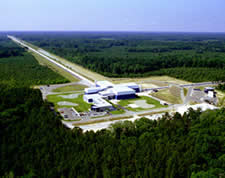
LIGO Livingston
Observatory |

LIGO Hanford
Observatory |
|
The NSF/MPS Laser Interferometer Gravitational-Wave Observatory (LIGO) is a facility dedicated to detection of cosmic gravitational waves and the harnessing of these waves for scientific research. It consists of two widely separated installations -- one in Washington and the other in Louisiana -- operated as a single observatory. LIGO is being built by the California Institute of Technology (Caltech) and the Massachusetts Institute of Technology (MIT). LIGO will function as a national resource for both physics and astrophysics and is becoming part of a planned worldwide network of gravitational-wave observatories. |
||
|
LIGO has agreements with VIRGO and collaborations with the UK-Germany GEO; with TAMA 300, the Japanese project, and with AIGO, Australia's proposed southern hemisphere gravitational wave observatory. the Construction Sites. |
||
The University of Wisconsin’s Synchrotron Radiation Center, supported by NSF/MPS Materials Research (DMR), as a national user facility, receives international financial support from the Canadian government, from the Ecole Polytechnique (Swiss Federal Institute of Technology), Lausanne, and from the Consiglio Nazionale delle Ricerche (Italian National Research Council) (CNR)to help underwrite the cost of researchers from these countries using this facility. A collaboration in soft X-ray spectromicroscopy between the Ecole Polytechnique and Wisconsin is developing the electron imaging spectromicroscope MEPHISTO to study the uptake of foreign elements in brain cells and other biological tissue. Other work with MEPHISTO spectromicroscopy involves collaboration with scientists with the Istituto di Struttura della Materia (ISM) in Rome, part of the CNR. A collaboration in photochemistry between McMaster University in Hamilton, Ontario, Canada and Wisconsin is aimed at breaking molecular bonds selectively by excitations from core levels of specific atoms in a molecule. There are no foreign resources provided directly to other national user facilities for NSF/MPS Materials Research. These facilities maintain an open door policy, without user fees, and provide access to their instruments on a competitive basis, giving priority to U.S. researchers. The National High Magnetic Field Laboratory (NHMFL), which is operated by Florida State University (FSU), Los Alamos National Laboratory and the University of Florida, with NSF/MPS funding, is extensively engaged in collaborations with international organizations to advance magnet technologies that enhance high field research research magnets. The expertise generated in the design and fabrication of high field research magnets extends far beyond Florida and Los Alamos to Europe, Asia, and Australia. The NHMFL pulsed field magnets have become an increasingly popular commodity among other pulsed field laboratories around the globe and reliable pulsed magnets are being fabricated for the following organizations: Technische Universitat in Austria; University of Braunschweig, Dresden Research Centre, and Johann-Wolfgang-Goethe University in Germany; University of New South Wales in Australia; Ruppin Institute of Higher Education in Israel; and Service National des Champs Magnetiques Pulses in France. In addition, the NHMFL has provided specialized technical information related to high field magnet technology and high-strength materials to the magnet laboratories at the University of Amsterdam and the Katholieke Universiteit Leuven. Researchers involved with the NHMFL's Pulsed Field Magnets have maintained a long-standing relationship with the Bochvar Institute in Moscow, Russia. Likewise, magnets designed and engineered by the NHMFL are being procured by the National Research Institute for Metals (NRIM) in Tsukuba, Japan. Collaborations with the Grenoble High Magnetic Field Laboratory have generated cost savings measures in resistive magnets for both laboratories. A Memorandum of Understanding was signed with the Nijmegen High Field Magnet Laboratory(Netherlands) in 1999 to pursue joint production of resistive magnet coils for the major upgrade of this facility. Essentially all of the NSF/MPS Materials Research Science and Engineering Centers (MRSEC) have active international collaborations ranging from interactions among individual scientists to Center supported workshops and symposia, as well as student and faculty exchange programs.
The Princeton Center for Complex Metals (PCCM) hosted in July 2000 the International Conference on Solid Films and Surfaces (ICSFS-10).ICSFS, previously held in Tokyo (1978), Washington (1981), Sydney (1984), Hamamatsu (1987),Providence (1989), Paris (1992), Hsinchu (1994), Osaka (1996) and Copenhagen (1998), is a very important forum of discussion of the latest experimental and theoretical advances in the field of solid films and surfaces. ICSFS typically attracts 200-250 scientists from all over the world. The Materials Research Laboratory(MRL) at the University of California-Santa Barbara (UCSB) was pivotal to a five-year, $15-million alliance formed in February 2001 to support research and education in advanced materials and in solid state lighting and displays between UCSB and Mitsubishi Chemical." International collaborations were specifically identified as areas of importance in the MRSEC Program Solicitation of 1999, and continues to be in the FY 2001 mcompetition. NSF/MPS physics-supported centers and facilities, such as the Joint Institute for Laboratory Astrophysics (JILA), the Cornell Electron Storage Ring (CESR), the Institute for Theoretical Atomic and Molecular Physics (ITAMP), and others, host visiting researchers from other countries, much as many U.S. scientists conduct research at similar facilities in other countries. As an example, as one of the world's foremost research and teaching institutes, JILA is an international center for collaborative research. The unique Visiting Fellows Program brings distinguished scientists from all over the world to JILA for up to 12 months to collaborate with resident scientists. The presence and participation of these visiting scientists is an important contribution to the atmosphere of scientific excellence at JILA. |
| Much of the science being conducted by JILA research groups is interdisciplinary, encompassing areas such as new states of matter (Bose-Einstein condensates), materials processing and nanometrology. Velocity-distribution data that confirm the discovery of a new state of matter, the Bose-Einstein condensate. The two right-most images, corresponding to lower temperatures, show multiple atoms coalescing into a single macroscopic quantum state. |  |
|
The facilities and centers supported by NSF/MPS Mathematical Sciences, such as the Mathematical Sciences Research Institute (MSRI) engage in exchanges of mathematical scientists with other countries. MSRI organized a workshop for October 2001 -- the NSF-funded Pan-American Advanced Studies Institute (PASI) on Inverse Problems (IP).One important objective of the PASI on IP Workshop is to foster international cooperation throughout the Americas by bringing different areas of expertise in the field of IP together in one event. Several of the PASIs funded so far have their own websites. The Institute for Mathematics and its Applications (IMA) was founded by and receives major support from Mathematical Sciences. It also receives support and direction from its Participating Institutions (including the National Research Institute for Mathematics and Computer Science (CWI) in the Netherlands and the "Istituto per le Applicazioni del Calcolo" M. Picone (IAC), the largest mathematical institute of the Italian National Research Council" (CNR)) and ; Participating Corporations, including international firms such as Siemens. The NSF funds several Science and Technology Centers (STCs) and Engineering Research Centers (ERCs), which promote long-term collaborative research across disciplines and at the forefront of scientific frontiers. NSF Industry/University Cooperative Research Centers (I/UCRCs) develop long-term partnerships among industry, academe, and government. Many of these centers have developed substantial international activities. As an example, increasingly, I/UCRCs are involved in international collaborations. In one partnership, the Queen's University at Belfast (I/UCRC) QUESTOR is providing a test bed for the University of Arizona I/UCRC for Microcontamination Control (EEC-9810181). The Queen's University will study the microbiology of organisms in a copper chemical/mechanical process pilot system and how they interact and obtain food (with support from the Northern Ireland Research and Technology Unit). · There is also a recently established collaboration between the I/UCRC for Low Power Electronics (CLPE) at the University of Arizona and the Silesian University of Technology in Poland, with an MOU signed in FY 2000. The MOU incorporates the capabilities of the Polish partners in industrial applications of mixed-signal low power electronics to complement the CLPE focus on low voltage, low power microelectronic circuits for portable, battery operated systems such as pagers, cellular phones, laptops, etc. |
|
|
||
|
In one US-Japan Cooperative Research award,
"Performance of Improved Ground under Strong Seismic Loading," parallel
studies of improved ground to serve as a basis for performance based
design are being conducted at PEER in collaboration with UC Davis
National
Geotechnical Centrifuge, and in Japan with the Public
Works Research Institute (PWRI) and the Port
and Airport Research Institute (PARI). Overall, the earthquake hazard mitigation work of NSF Earthquake Engineering Research Centers develops the knowledge that will estimate seismic hazard and enhance the reliability and performance of the world's infrastructure systems. This work was identified as one of NSF's major accomplishments, in celebrating its 50th anniversary in 2000. In the future, NSF will fund the development of a vast new virtual center — the George E. Brown, Jr. Network for Earthquake Engineering Simulation (NEES) — which will link experimenters and analysts worldwide in an Internet-based system created to share experiments, results, observations and models. A number of NSF Science and Technology Centers (STCs) are conducting joint research and visiting scientist programs with partner institutions in Asia, Europe, Canada and Israel. Among these are the NSF Biological Sciences Directorate's (BIO) Center for Light Microscope Imaging and Biotechnology (CLMIB) at Carnegie Mellon University. The Center's research extends beyond Carnegie Mellon through collaborative projects with other academic institutions across the US and in Europe. BIO's Michigan State University Center for Microbial Ecology (CME) founded in 1989 as one of the first eleven STCs " graduated" in FY2000. International recognition of the Center led to several unique collaborative agreements. One of these was with two institutes in Japan focused on the microbial evolution of catabolic pathways. The Center also established collaborative research programs with Russian scientists on microbial communities preserved in permafrost soils that are millions of years old and on the genetic and biochemical characterization of microorganisms with novel biodegradation traits. Another collaboration was established between scientists from the Center and the National Institute for Resources and the Environment (NIRE) in Japan. The focus of this collaboration was to develop and use novel methods to assess the distribution in the environment of genes required for the catabolism of pollutants. These collaborations provided our students with exposure to excellent and unique science and a perspective of how science is conducted in other cultures. The Center also initiated an international collaboration to integrate existing databases with information on microorganisms. The goal was to enhance access to these databases in ways that would allow investigators to understand better the evolutionary relationships among microorganisms and their characteristics. This collaboration included the American Type Culture Collection, the Japanese Collection of Microorganisms, the German Culture Collection, the Ribosomal Database Project , and Bergey's Manual Trust. NSF Computer Science and Engineering Directorate's (CISE) Graphics and Visualization Center researchers are working in advisory capacities with Wholly Light Graphics in Jerusalem, Israel, the Center for Complex Systems and Visualization, Bremen, Germany, and the Fraunhofer Center for Research in Computer Graphics (CRCG), based in Providence, Rhode Island. Two Center researchers hold positions on the technical advisory board of CRCG, and Fraunhofer IGD, the parent company, based in Darmstadt, Germany, chose Providence, Rhode Island as the site for its only US branch in order to be near the Center site at Brown University Both the Center and the CRCG are working on large-scale telecollaboration projects. The CRCG is supplying the Center with a Barco Baron stereoscopic rear-display table so that gestural modeling techniques can be integrated into CRCG's custom CAD system. The Center will also benefit from the CRCG's ATM connection with Fraunhofer IGD in Darmstadt and will contribute to the development and testing of VRTP (Virtual Reality Transfer Protocol), among other projects. International activities at the Cornell Center site have provided the University of Bristol in the UK reflectance measurements of paint samples for the purpose of studying in detail the perceptual equivalence of a real and a very accurately modeled virtual scene. These measurements are also being made available with the Cornell archive of data from the Light Measurement Lab . |
|
||
|
Another NSF center with international activities is the MPS Center for Environmentally Responsible Solvents and Processes In FY 2000, the Center provided outreach and educational tours of laboratory facilities (primarily at North Carolina State University(NCSU) and the University of North Carolina at Chapel Hill (UNC-CH)) to academic professionals from international institutions from China, Japan, Canada, Brazil, and Italy in response to requests for knowledge about high-pressure equipment and instrumentation necessary to conduct experiments in CO2. The Geological Sciences Directorate's (GEO) Center for Clouds, Chemistry, and Climate (C4) is involved in the Indian Ocean Experiment (INDOEX). In the INDOEX program, premier environmental scientists and university and goverment institutions from the US, Europe and Indian Ocean region collected in-situ data on the regional cooling effect of sulfate and other aerosols. Building on data collected 1995-1998, an intense field campaign was undertaken during January to April, 1999. Field data was used to calibrate National Aeronautics and Space Administration's Earth Observing System (EOS) instruments to obtain a regional map of the aerosol cooling effect. In conjunction with the regional scale satellite data, the field data was used to include aerosol effects in global warming prediction models. |
||
|
![]()
Linkages To Research Programs of Other Countries
NSF’s Overall Approach
The Foundation stands firmly behind the principle of open and reciprocal access to research and education facilities and programs by U.S. researchers and students and those of foreign countries. By and large, the Foundation encourages the U.S. scientists and engineers it supports to make their own arrangements abroad. These arrangements are made on an ad hoc basis or within the framework of university, center, or laboratory agreements with foreign partners.
The Foundation also maintains a range of intergovernmental agreements or other less formal arrangements with science and engineering organizations in other countries. Some of these (China, Japan, Russia, example) are elements of broader intergovernmental agreements managed by the Office of Science and Technology Policy, the Department of State, and other federal agencies.
While these agreements are not typically concluded for the purpose of ensuring reciprocal access, they usually contain provisions for doing so and the Foundation has, on occasion, invoked them.
While NSF has long developed access to and strong bilateral working relationships with counterpart organizations in individual European countries, a comparable relationship with the European Union, a multilateral organization, continued to evolve. In December 1997, the US and the European Commission (EC) of the European Union (EU) signed an " umbrella agreement" to cooperate in science and technology. The most important effect has been to open cooperation to US scientists in such European Union research fields as materials research, manufacturing research, the social sciences, and areas of biotechnology. Since the signing of the Agreement, NSF has developed "implementing arrangements" for cooperation in computer science and technology, materials research, environmental research, and the geo- and Polar sciences.
In FY2001, more opportunities opened for the US research community as current NSF awardees became eligible in a Dear Colleague Letter to request support for participation in an international training-through-research program of the EC. Specifically, NSF invited grant-supplement requests proposed in partnership with European teams that were requesting support from the Research Training Network (RTN) activity of the EC's Improving Human Potential Programme (IHP).
 Mineral Transformations, an EU Research Training Network, investigates structural, kinetic and thermodynamic aspects of transformation processes in minerals. The network involves teams from the seven institutes indicated on the map of Europe. |
Problems of access are generally beyond the scope of this report and will not be covered except to note the following. Although the Foundation generally does not see broad access problems looming on the horizon, there are two specific issues of potential great concern for the future: laws and treaties being considered that could jeopardize the full and open exchange of scientific data and fees for the use of facilities or for access to research sites.
Regarding the first, NSF and several other federal science agencies supported a National Research Council (NRC) study A Question of Balance that identifies and evaluates the various existing and proposed policy approaches (including related legal, economic, and technical considerations) for protecting the proprietary rights of private sector database rights holders, while promoting and enhancing access to scientific and technical (S&T;) data for public-interest uses.
With respect to access to ecological research sites, NSF participates in interagency activities related to international conventions (e.g. The Biodiversity Convention) and negotiations regarding access to genetic resources and sharing of benefits from bioprospecting, such as the Meeting of the Ad Hoc Open-ended Working Group on Access and Benefit-sharing.
The Foundation maintains and participates in over a dozen formal bilateral agreements (e.g., with Brazil, China, France, Hungary, Indonesia, Japan, Korea, Mexico, Czech Republic, Russia) of the many bilateral S & T agreements between the US and other countries and about twice that number of informal bilateral arrangements for cooperation in all NSF-supported areas of science and engineering. Most of the NSF agreements are centrally managed and implemented on behalf of the Foundation by NSF/INT.
U.S. scientists (partially funded by NSF/GEO and INT) are working with colleagues from Russia (funded by the Russian Foundation for Basic Research (RFBR)) and from Japan to study subduction processes and paleoseismology along the Kurile-Kamchatka-Aleutian Arc. About 150 scientists (including many from these three countries) will gather at the 3rd Biennial Workshop on Subduction Processes along the Arc which will be convened in Fairbanks in June 2002 to review scientific progress in this area and to identify potential future research. The several thousand mile long tectonic boundary plate - one of the most active sites of earthquake and volcanic eruptions on Earth - crosses borders from the volcanic Aleutian Arc of southern Alaska to the Kamchatka/Kuril Arcs of Russia and Northern Japan.
 Also,
research directorates manage (or, in some cases, co-manage with other
federal agencies) and implement subject-specific bilateral (or, in a few
cases, multilateral) agreements or informal arrangements. Most of these
are in earth, ocean or atmospheric sciences (NSF/GEO), polar programs
(NSF/OPP), and engineering (NSF/ENG).
Also,
research directorates manage (or, in some cases, co-manage with other
federal agencies) and implement subject-specific bilateral (or, in a few
cases, multilateral) agreements or informal arrangements. Most of these
are in earth, ocean or atmospheric sciences (NSF/GEO), polar programs
(NSF/OPP), and engineering (NSF/ENG).
Joint Programs
In addition to any arrangements related to the global- or regional-scale projects described in the "Global-Scale Projects" section, the Foundation supports the following joint programs designed to facilitate the involvement of NSF-supported U.S. scientists and engineers in international collaboration:
A joint program with Japan, the US-Japan Joint Optoelectronics Program (JOP) promotes the supply of prototype optoelectronic devices and services for development of computing applications. Importantly, the JOP offers a secure and convenient system for offering and obtaining optoelectronic prototypes.
ENG represents NSF on the US Joint Management Committee(JMC) for the JOP, comprising Department of Commerce (NIST and Office of Technology Policy), NSF, Defense Advanced Research Projects Agency, Department of Energy, Department of State; . NIST chairs the US JMC. The JOP, first implemented as a three-year experiment in FY 1995, has been extended through FY 2002. The JOP has developed a unique international broker system that brings users and suppliers of optoelectronics together, by providing users with novel prototype optoelectronic devices, circuits, and modules through access to leading-edge optoelectronic fabrication facilities.

|
Rochester Photonics Corporation Diffractive/Refractive Achromats, provide high performance imaging over wide spectral ranges, a US prototype JOP technology. Prototypes cannot be catalog items, and they must be for the development of computing applications. "Computing" is defined broadly, to include processing, interconnects, computer networks, and peripherals. |
The Japanese Ministry of International Trade and Industry (MITI) has provided approximately $800K/year to the US in support of the JOP US broker organization. NSF and Defense Advanced Projects Agency (DARPA) have each provided $200K/year in seed funding to US users of this technology. A total of 42 transactions of prototype devices have now been completed between the US and Japan users and suppliers; 14 of these transactions were in FY 2000.
One award to Carnegie-Mellon University, Multilingual Concept Hierarchies for Medical Information, is striving to extend the state of the art in high performance multilingual information access, both in terms of underlying science and its technological realization via a functional prototype for English and German in the biomedical domain.
NSF also considers proposals for cooperative activities involving France’s Institut National de Recherche en Informatique et Automatique (INRIA). International Digital Libraries fosters cooperation between NSF and digital libraries projects supported by the United Kingdom, Germany and the European Union,as described in the Global Scale chapter of this report.
NSF-CONACyT continues as a joint program of NSF/CISE with Consejo Nacional de Ciencia y Tecnologia (CONACyT) (National Council of Science and Technology Research) of Mexico, supporting efforts in international cooperative research and research infrastructure in computer science, information systems, computer engineering, and engineering research.
NSF-CNPq, a joint program of NSF's Computer and Information Sciences Engineering (CISE) Directorate and Conselho Nacional de Desenvolvimento Cientifico e Tecnologico da Pesquisas (CNPq, or National Council of Scientific and Technological Research) in Brazil announced in FY2000 a pilot activity to support new efforts in international cooperative research in any CISE-related area.
|
Map showing Antarctica and location of Vostok Ice Core. Colors indicate elevation. |
NSF/ENG has supported the deployment of rapid-response reconnaissance teams following earthquakes and tsunamis. In FY2000, ENG supported visits following the 1999 earthquakes in Taiwan and Turkey.
The NSF/ENG Pacific Earthquake Engineering Research Center (PEER) Lifelines Program hosts collaborative research with Sakarya University and Middle East Technical University (METU) in Turkey documenting the incidents of ground failure resulting from the August 1999 Kocaeli, Turkey Earthquake. Also, PEER hosts cooperative work with Catholic University of Peru in geotechnical earthquake engineering reconnaissance of the June 2001, Southern Peru Earthquake.
Partially funded by the NSF, the Earthquake Engineering Research Institute (EERI) conducts post-earthquake investigations for the purpose of improving the science and practice of earthquake engineering and earthquake hazard mitigation practices. An EERI Special Reconnaisance Earthquake Report on the Chi-Chi, Taiwan Earthquake of September 21, 1999 reports on the area affected by the earthquake surveyed by an EERI reconnaisance team.

Fault surface rupture across Shih-Kang Dam, Chi-Chi, Taiwan Earthquake of September 21, 1999. |
Access To Foreign Facilities And Research Groups
Some the areas of science and engineering in which significant international interaction occurs are the physical sciences, especially physics and materials research.
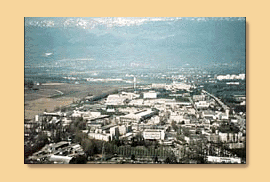 |
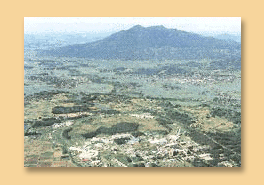 |
 In atomic, molecular, and optical physics, NSF/MPS supports US researchers working at CERN (Geneva), KEK (Japan), Rutherford-Appleton (England), and in France, Germany, and Brazil. |
|
In particle physics, NSF supports about 80 researchers to work on the LEP and NOMAD detectors at CERN and the ZEUS detector at DESY (Hamburg). Involvement will also be at the ATLAS and Compact Muon Solenoid (CMS) detectors at the Large Hadron Collider (LHC) at CERN, when it is completed. (See "Overseas Facilities" Section)
U.S. researchers in nuclear physics are supported to work at TRIUMF (Canada), PSI (Zurich), GSI, HERA, and MAMI (Germany), Novosibirsk (Russia), NIKHEF (Holland), and CERN.
International interaction is critical to world leadership in science, especially in the MPS fields. Professor James Cronin of the Uniiversity of Chicago was one of twelve scientists awarded the 1999 National Medal of Science for their discoveries and lifetime achievements. Cronin was cited as a leader in creating an international effort to determine the unknown origins of very high-energy cosmic rays.
|
In materials research, an estimated 10-15% of NSF-supported researchers are engaged in research collaboration with foreign scientists and as many as half of them take sabbaticals overseas. In the area of electronic structure, there is a trend toward cooperation in Europe. US investigators in materials research make frequent use of the Institut Laue Langevin (ILL) (Grenoble), the CNRS/MPI Grenoble High Magnetic Fields Laboratory (GHMFL) (Grenoble), the National Institute for Materials Science (NIMS) (Tsukuba, Japan), and Oxford Instruments (England).
![]()
International Experiences for New Scientists and Engineers
In pursuit of its mission, to invest in PEOPLE to develop "a diverse, internationally competitive and globally engaged workforce" of scientists and engineers, the Foundation uses both fellowships and participation in research to provide US students and early career scientists and engineers with opportunities to gain international professional experience. The majority gain that experience through participation in international research projects. Many others become involved internationally through the Foundation’s fellowships programs.
Post Doctorate & Early Career
A number of NSF programs are designed specifically for tenure outside the United States. To introduce scientists and engineers in the early stages of their careers to research opportunities abroad, the INT International Research Fellowship Program (IRFP) provides support to conduct research at science and engineering establishments in all foreign countries. Applicants are eligible in any area of science and engineering supported by NSF and may conduct their research anywhere in the world. IRFP is supplemented by an INT program of Research Fellowship Opportunities in Japan conducted in partnership with Japanese agencies.
Over 40 young postdoctoral researchers received grants from the IRFP in FY2001 to carry out advanced research in their fields at overseas universities and research institutes. These grants support residence abroad of three to 24 months. The 24-month period may include one year (or some portion of the total duration) at the foreign site and one year (or duration equal to the foreign tenure) used as a "re-entry" year in the United States.
 One 2000 award provided support to carry out research at the Institute of Condensed Matter Chemistry (ICMCB) in Bordeaux, France. The aim is to determine and improve the electrochemical behavior of novel layered lithium manganese derivatives with the O2 type structure as the positive electrode in lithium rechargeable cells. ICMCB is one of the largest public research labs in the world involved in solid state chemistry and materials science. |
At the request of the Department of State, NSF/EHR administers a program of NATO Postdoctoral Fellowships in Science to promote a closer collaboration among the scientists of member and NATO Partner countries. Approximately 20 fellowships are made to US institutions that would like to host a scientist from a NATO Partner Country. Citizens from the Czech Republic, Hungary and Poland will have Partner Country status for the 2002 competition. Fellowships are in any area of science and engineering supported by NSF.
In FY2001, MPS launched the Distinguished International Postdoctoral Fellowship Program. Also, the MPS Division of Mathematical Sciences (together with the Division of Physics and INT) continued their support for postdoctoral fellows at the international institute Institut des Hautes Etudes Scientifiques (IHES) in Paris, France. This institute supports postdoctoral study in mathematical physics and geometry.
In NSF/MPS particle physics, postdoctoral researchers supported spend time in residence at overseas research facilities or engage in some international activity as do those in atomic, molecular, and optical physics and in the Mathematical Sciences Postdoctoral Research Fellowships Program.
Some BIO fields, Biological Informatics and Microbial Biology offer postdoctoral research fellowships to assist new scientists to direct their research efforts across traditional disciplinary lines and to avail themselves of unique research resources, sites, and facilities, including foreign locations.
Also, in the biological sciences, NSF is one of four US federal agency contributors to the international Human Frontier Science Program (HFSP) which involves about 330 long-term fellowships, about 30 short-term fellowships, and about 150 cooperative research projects annually, according to the HFSP FY2000/2001 Annual Report. (See also "Human Frontier Science Program" in Global Scale Projects section)
In fields such as the geosciences, systematic biology, and anthropology that have a long-standing tradition of international fieldwork, graduate students and postdoctoral researchers are supported primarily through research grants. In addition, GEO supports NCAR's Advanced Studies Program (ASP) Postdoctoral Program. One ASP 2000 postdoctoral research project developed an experiment to measure the time scale for condensational growth of aerosol particles. New equipment was constructed for this experiment, and a short field campaign was conducted in Mexico City where organic aerosols are present in high concentration. Collaborations included Universidad Nacional Autonoma de Mexico (UNAM) and the Institute of Atmospheric and Oceanic Sciences, Consiglio Nazionale delle Ricerche, Italy. Preliminary findings indicate that such aerosol particles may be very rare.
NSF/ENG divisions and INT co-fund awards that involve US principal investigator (PI), graduate student and postdoc collaboration with counterparts in other countries. As an example, one award supports an integrated program of research for exploiting all available modes of diversity in wireless communication.
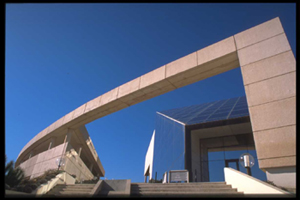
|
UNE GRANDE ECOLE D'INGENIEURS ET UN CENTRE DE RECHERCHEA key element of this project is the integration of student and faculty research activities at two US universities (University of Wisconsin, University of Colorado) with Eurecom in France, the later a recipient of an IEEE Education Award for its innovative integration of mobile wireless, multimedia, and networking. The likelihood of success for this collaborative program is high, because working relationships among the three schools have been established through prior visits, sabbaticals, and collaborations. |
The NSF/EHR NATO Advanced Study Institutes Travel Awards enable recent US PhDs (and some advanced graduate students) to attend Advanced Study Institutes (ASI) sponsored by the North Atlantic Treaty Organization (NATO), centered in Brussels, Belgium. The ASIs are held predominantly in the NATO-member countries of Europe, but include the Partner Countries in Central and Eastern Europe.The 2001 list is also available on the NATO Home Page. As an example, about twenty US mathematicans were invited participants to the NATO ASI, Symmetric Functions 2001: Surveys of Developments and Perspectives, Isaac Newton Institute for Mathematical Sciences,Cambridge, UK, 25 June – 6 July 2001.
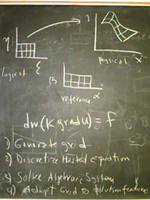
|
The Department
of Energy and the NSF support a limited number of Pan
American Advanced Studies Institutes (PASI) modeled on the NATO
Advanced Studies Institutes. Pan American Advanced Studies Institutes
are short courses of two to four weeks duration, involving lecturers
of international standing at the advanced graduate and postgraduate
level from the Americas. PASIs aim to disseminate advanced scientific
and engineering knowledge and stimulate training and cooperation among
researchers of the Americas in the basic sciences and engineering
fields. One FY2001 PASIaward supports the Computational Science Research Center, San Diego State University in conjunction with the Facultad de Matemática, Astronomía y Física, Universidad Nacional de Córdoba to host the First Pan-American Advanced Studies Institute in Computational Science and Engineering,Cordoba, Argentina, July 2002 The goals of this Institute are to promote in-depth computational science and engineering knowledge, encourage training, and foster cooperation among diverse researchers, academia and higher education learners of the Americas. |
Graduate Students
Programs for graduate students include the NSF/INT Summer Programs in Japan, Korea and Taiwan. Over one hundred US graduate students in science and engineering participated in the program in 2000. The year was notable in that Taiwan hosted students for the first time. Since their start in Japan in 1990 and in Korea in 1995, the programs have enabled a total of over 700 American graduate students to gain first-hand experience in a research laboratory in Japan, Korea, or Taiwan.
In addition to a research internship, the Summer Programs provide introductory foreign language training, and exposure to science and science-policy infrastructure. The goals of the program are to introduce US graduate students to science and engineering research laboratories in Japan, Korea, and Taiwan, and to initiate personal relationships that will better enable students to collaborate with foreign counterparts in the future.
  Summer Programs Report: The Increased Fluorescence Intensity of HeLa Cells Transfected With The Improved Pericam. |
A long-term goal of the program is to enable the United States to gain maximum benefit from international scientific and technical interactions.
As an example, one of the FY2000 Summer Programs, Reports, Improvements in GFP (Green Fluorescent Protein) Indicators for Visualizing Intracellular Functions in a Live Cell was prepared by a graduate student in Chemistry, Stanford University. The Brain Science Institute at RIKEN (The Institute of Physical and Chemical Research) in suburban Tokyo, hosted the work on visualizing intracellular functions in a living cell using a fluorescent probe. Conducting research in the lab during the summer broadened the student's science horizon to molecular biology and cell biology in addition to teaching cell imaging techniques.
Initiated in 1997, the NSF-wide Integrative Graduate Education and Research Traineeship (IGERT) program was developed to create a new model for Ph.D. training that was more responsive to emerging research opportunities that cross disciplinary boundaries. It is also intended to contribute to the development of a diverse, globally-aware, science and engineering workforce.NSF encourages Principal Investigators to include international collaborations in their proposals for new IGERT projects. Lists of IGERT projects, along with links to project websites, are available on the NSF website at http://www.nsf.gov/igert.
To promote international research experiences in IGERT projects, NSF's Office of International Science and Engineering (INT) begin in FY1999 to offer every IGERT project leader an opportunity to request additional funding for international activities. These requests are submitted after an IGERT project has been in operation for a year. As a result, 15 supplementary awards have been made by INT since 1999. (see tables).
In general, these "international supplements" are being used to support longer-term visits (generally 3-6 months) by US Ph.D. students to laboratories in other countries where they study under a non-US supervisor. These co-supervisory arrangements are usually the by-product of ongoing research collaborations between the professors involved in the IGERT project and their colleagues at foreign research facilities.
For example,

|
Surface Magic Clusters (SMC) form on Si(111) surface One 1999 IGERT award, supports the establishment of a multidisciplinary, multi-institutional graduate training program of education and research at five New York City and state institutions (City College of New York, Hunter College, The College of Staten Island, Columbia University and the University of Rochester) in areas of nanostructural materials and their uses in photonic devices.The "international supplement" is being used to support longer-term visits by Ph.D. students to: Max Plank Institute for Quantum Optics, Garching, Germany; Universite Louis Pasteur , Strasbourg, France;Physical Chemistry Laboratory of the Swiss Federal Institute of Technology Zurich; Center for Research and Advanced Studies of the National Polytechnic Institute of Mexico; The Institute for Atomic and Molecular Science, Taiwan. |
NSF Graduate Research Fellowships offer three years of support that can be used over a five year period for advanced study to approximately 900 new graduate students each year. Although recipients of NSF Graduate Research Fellowships may take their tenure in any graduate institution in the world that will accept them; few each year select overseas institutions. The Fellowship program offers a one-time international research travel allowance for fellows who plan to study or do research full-time at a foreign site for at least 3 continuous months. For fellows wishing to conduct research in close cooperation with a host country investigator, INT offers additional support for international collaboration.
BIO Doctoral Dissertation Improvement Grants support field research outside the US and collaborations with scientists at foreign institutions.Some SBE programs such as Archaeology and Cultural Anthropology, also consider proposals for doctoral dissertation improvement assistance,
INT dissertation enhancement projects support dissertation research conducted by graduate students at a foreign site, as described in the program announcement International Opportunities for Scientists and Engineers (NSF 00-138), Students are expected to work in close cooperation with a host country institution and investigator.
One FY2000 dissertation enhancement award , in intelligent and information systems involves a Carnegie Mellon University professor and graduate student and a research group of the Swiss Federal Institute of Technology (Ecole Polytechnique Federale) in Lausanne, Switzerland. The project, which addresses research and applications in vehicle operation (remote driving) in general, focuses on advanced teleoperation operator interfaces.
NSF/OPP supported in FY2000 the Integrative Biology and Adaptation of Antarctic Marine Organisms project, a month-long, international, advanced-level training course taught in Antarctica at the Crary Science and Engineering Center, McMurdo Station, Antarctica. (NSF Press Release 00-07)
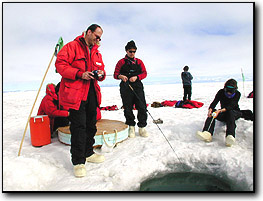
|
An award
to the Department of Biological Sciences at the University of
Southern California, the course was designed to provide graduate students
with an education that approximates the working conditions of the
hundreds of scientists who travel to Antarctica every year under NSF's
auspices. The course attracted an extremely competitive group of students and scientists and introduced new researchers to Antarctica. The participants for January, 2000 included 15 graduate students; 5 postdocs, and 5 faculty. Of these, 14 were from the US and 11 from other countries. There were 13 males and 12 females. |
Undergraduate Students
In 1998 an NSF pilot effort allowed US and French universities to swap undergraduate students in chemistry. Nine students from US universities conducted research in groups at the Universite Pierre et Marie Curie in Paris, the University Louis Pasteur in Strabourg, and the University of Bordeaux. In turn, ten French students participated in the NSF Research Experiences for Undergraduates (REU)summer programs in Florida state. The students worked on problems associated with polymer materials, materials chemistry and optical science. The grant from NSF/INT, NSF/MPS and NSF/ENG to the University of Florida and Central Florida University resulted in the establishment of US-France Research Experiences for Undergraduates, a program that currently involves 15 students each way and research groups at French Grandes Ecoles and CNRS university laboratories. The program has attracted corporate funding from IBM, 3M and Dupont and funding from the CNRS and French Ministry of Research and Technology.
Following that and other early efforts, INT now systematically supports overseas REU sites for US undergraduates. For example, in 2000, INT funded the Department of Civil and Environmental Engineering Clarkson University REU, Marine Science and Engineering in China provided a summer research program including environmental science, marine biology, oceanography, structure engineering, coastal engineering, material science, and others. The summer research projects were carried out at the Ocean University of Qingdao (OUQ) and Dalian University of Technology.
In 2001, INT funded the Rutgers Math Department and Center for Discrete Mathematics and Theoretical Computer Science (DIMACS) to offer the third US-Czech REU program during which DIMACS partners mentored undergraduate participants. Each year, five US students are selected to spend the final two and a half weeks of their eight-week summer REU program working in Prague at the Center for Discrete Mathematics and Theoretical Informatics and Applications (DIMATIA)of Charles University. Students selected to participate in this program generally exhibit strong interests in combinatorics.

The University of New Mexico(UNM) offers (Summer 2001 and 2003) an intensive summer field course, Biodiversity of Australia, taught in Australia and at UNM. A REU-like activity, funded by INT, it provides students an opportunity to visit Australian habitats and biomes and to meet with native Australians throughout the continent "down under." Local faculty, scientists, and aboriginal peoples act as lecturers whenever possible. |
Also, INT awarded a planning grant to the Indiana University Cyclotron Facility to develop a Summer REU Program to provide international research experience in experimental and theoretical nuclear physics, and in experimental accelerator and medical physics and nuclear chemistry at the Research Center for Nuclear Physics, Osaka
In FY2000, Alicia Soderberg, an undergraduate from Bates College, Maine, continued work she began as a 1999 CTIO REU student. As a member of the supernovae search team, she made observations at the Canada-France-Hawaii Telescope. Featured as the Science Breakthrough of the Year in 1998, this research on supernovae has altered our view of the structure and geometry of the universe. |
Also, in Summer 2000, an NSF Physics Division, along with INT, funded REU program allowed students and teachers to conduct hands-on experiments with the particle accelerators and detectors at CERN -- the world's largest particle physics research center. Ten US undergraduates (from all over the US) and four high school teachers (from Massachusetts) worked alongside senior scientists investigating the building blocks of matter and the fundamental forces of nature.
Another example of a REU Program research site outside the US, the Department of Geosciences University of Arizona provides research opportunity for outstanding undergraduates interested in tropical lakes, the Nyanza Project. Sponsored by the NSF Division of Atmospheric Sciences and INT, and the Worldwide Fund for Nature (WWF), the project is run for the International Decade of East African Lakes (IDEAL), an organization that promotes research and training on African lakes. Participants join teams of US and African students in training and independent research, planned for Summer, 2002.
Undergraduates pursuing research in glass/ceramics are gaining unique and valuable international experience through a 1999 MPS/DMR award for a novel program developed by Coe College. The program is of international scope, collaborations being conducted with scientists at Reading University (UK), Rostock University (Germany), Sojo University (Japan), and Fudan University (China). Nine papers and five talks have been completed, while nine additional papers have been accepted for publication. Two undergraduate students will do research in neutron scattering for one month at the Rutherford Appleton-Laboratory in Harwell, England, and the Institut Laue-Langevin reactor lab in Grenoble, France.
![]()
International Science and Engineering Information
The Foundation’s primary approach to tracking developments in research and education in other countries has been to leave it to U.S. scientists, engineers, and educators to draw on information networks in their disciplines. The Foundation’s support and encouragement of internationally based research, research collaboration, and overseas training (all described above) provide U.S. participants with the opportunity to be informed first hand of the work performed by their colleagues in other countries.
This section of the report outlines some of the approaches currently used by the Foundation to access information about science and engineering in other countries. That information serves two purposes:
- One purpose is to complement the information available through other means to U.S. researchers and educators.
- The other purpose is to assist Foundation staff (at both the senior and program levels) in managing the international dimension of the NSF mission.
Participation in International Meetings
The Foundation enables an estimated 5,000 US scientists, engineers, and educators to participate in international research- and education-related meetings. Much of this support is provided under research grants, some as block grants. The meetings range from large international science and engineering conferences to seminars or workshops for the planning and development of international projects and programs.
A significant number of the participants are in the geosciences, in mathematics and the physical sciences. ENGINEERING also provides support for conferences. The remainder are in the biological sciences, social and behavioral sciences, computer sciences and engineering, and in the area of education. Also, INT supports bilateral seminars or workshops for the planning and development of international projects and programs.
Surveys and Assessments
ENG has sponsored a number of international evaluations by the World Technology Evaluation Center(WTEC) (WTEC) of the International Technology Research Institute (ITRI) at Loyola College of Maryland. These studies assess the competitive status of U.S. efforts, current collaborative activities, and identify opportunities for new approaches in U.S. research programs and topics for further international cooperation. These evaluations assist the Directorate in its strategic investment planning.
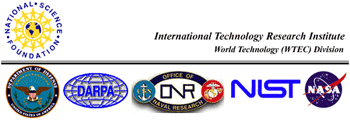
|
In FY 2000, ENG supported major evaluations of environmentally
benign manufacturing and tissue
engineering. WTECH continued an international comparative study on Applying Molecular and Materials Modeling and an assessment of Environmentally Benign Manufacturing (EBM) Technologies. |
The NSF/SBE Division of Science Resource Studies (SRS) has responsibility for Science and Engineering Indicators .
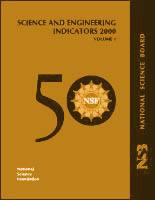 |
This is the flagship report of the NSF for reporting on national
and international trends in science and technology investments, outcomes,
and policies. For example, S & E Indicators reports on
The Science and Technology Portfolios of Nations and International
Scientific Collaboration. The report also presents trends in regional distribution of world publication of scientific articles. |
Other recent SRS publications report on international resources for science and technology, including
- Human Resource Contributions to U.S. Science and Engineering From China (NSF 01-311)
- Graduate Education Reform in Europe, Asia, and the Americas and International
Mobility
of Scientists and Engineers: Proceedings of an NSF Workshop (NSF 00-318) - Latin America: R&D; Spending Jumps in Brazil, Mexico, and Costa Rica (NSF 00-316)
NSF Offices in Tokyo and Europe
The Foundation supports offices in Tokyo and Paris. Their function, in part, is to monitor developments in Japan and in Eastern and Western Europe of significance to NSF management.

|
The Tokyo Office produces Tokyo Report Memoranda primarily for the use of NSF management and staff, but makes them widely available by electronic means. The Office also disseminates Special Scientific Reports on research developments in Japan that are related to NSF's mission. |
Information reported, both in formal reports and in ongoing communications with headquarters, pertains primarily to research and education policy, and changes in national research budgets, institutions, and key personnel.

|
The Europe Office produces periodic reports
covering some aspect of European science. More recently, the office has begun to emphasize the identification of significant opportunities in Europe for US researchers. |
Both offices facilitate and support institutional relationships between NSF and its partners in Europe and Japan. The Tokyo office also seeks opportunities for expanding NSF cooperation elsewhere in the East Asia and Pacific region. The EUR Office expands/promotes opportunities via European multilateral organizations and in the Newly Independent States of the former Soviet Union.
![]()
Notes
International Dimensions of NSF Research and Education, updates its predecessors, International Dimensions of NSF Research and Education-FY1997 (August 1998)and The International Activities of The Foundation, prepared for the NSB March 23, 1995 discussion of international issues.
![]()
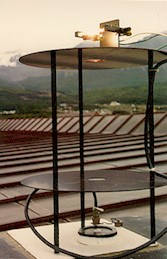


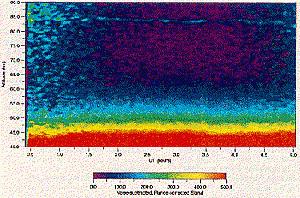










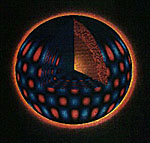




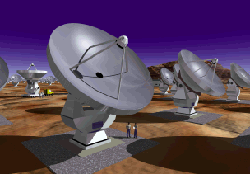

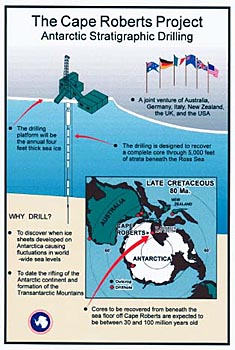
 This
proof-of-concept experiment is managed by the NSF-supported University
Corporation for Atmospheric Research (UCAR), with additional US
support from NOAA, NASA, USAF, and ONR. The National Science Council
(NSC) of Taiwan provides a large share of the support for this project.
This
proof-of-concept experiment is managed by the NSF-supported University
Corporation for Atmospheric Research (UCAR), with additional US
support from NOAA, NASA, USAF, and ONR. The National Science Council
(NSC) of Taiwan provides a large share of the support for this project.
